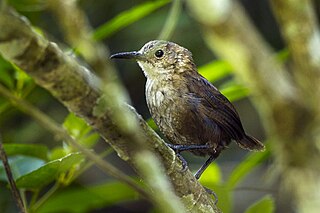
The bearded wood partridge is a bird species in the family Odontophoridae, the New World quail. It inhabits the Sierra Madre Oriental of Mexico.

The spotted wren is a species of bird in the family Troglodytidae. It is endemic to Mexico.

Boucard's wren is a species of bird in the family Troglodytidae. It is endemic to Mexico.

The Peruvian wren is a species of bird in the family Troglodytidae. It is endemic Peru.

The bar-winged wood wren is a species of bird in the family Troglodytidae. It is found in southern Ecuador and northern Peru.

Hylorchilus is a genus of bird in the family Troglodytidae. It contains the following species:

Sumichrast's wren, also known as the slender-billed wren, is a species of bird in the family Troglodytidae. It is endemic to Mexico.

The southern nightingale-wren, also known as the scaly-breasted wren, is a species of bird in the family Troglodytidae. It is found in Bolivia, Brazil, Colombia, Costa Rica, Ecuador, Panama, Peru, and Venezuela.

The northern nightingale-wren, or nightingale wren, is a species of passerine bird in the family Troglodytidae. It is found in Belize, Costa Rica, Guatemala, Honduras, Mexico, and Nicaragua.

The timberline wren is a species of bird in the family Troglodytidae. It is found in Costa Rica and western Panama.

The black-throated wren is a species of bird in the family Troglodytidae. It is found in Costa Rica, Nicaragua, and Panama.

The Inca wren is a species of bird in the family Troglodytidae. It is endemic to Peru.

The fawn-breasted wren is a species of bird in the family Troglodytidae. It is found in Bolivia, Brazil, and Paraguay.

The spot-breasted wren is a species of bird in the family Troglodytidae. It is found in Belize, Costa Rica, El Salvador, Guatemala, Honduras, Mexico, and Nicaragua.

Cabanis's wren is a species of bird in the family Troglodytidae. It is found in Belize, Costa Rica, El Salvador, Guatemala, Honduras, Mexico, and Nicaragua.

The whiskered wren is a species of bird in the family Troglodytidae. It is found in Colombia, Ecuador, and Venezuela.

The sooty-headed wren is a species of bird in the family Troglodytidae. It is found in Colombia and Panama.

The stripe-breasted wren is a species of bird in the family Troglodytidae. It is found in Honduras, Nicaragua, Costa Rica, and Panama.

The canebrake wren is a species of bird in the family Troglodytidae. It is found in Costa Rica, Nicaragua, and Panama.

The isthmian wren is a species of bird in the family Troglodytidae. It is found in Costa Rica and Panama.






















